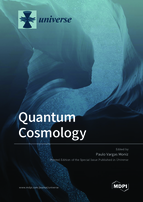Quantum Cosmology
A special issue of Universe (ISSN 2218-1997). This special issue belongs to the section "Cosmology".
Deadline for manuscript submissions: closed (15 October 2021) | Viewed by 32511
Special Issue Editor
Interests: quantum cosmology; general relativity; mathematical physics; foundations of quantum mechanics
Special Issues, Collections and Topics in MDPI journals
Special Issue Information
Dear Colleagues,
Within the second half of the last century, quantum cosmology concretely became one of the main research lines within gravitational theory and cosmology. Substantial progress has been made. Furthermore, quantum cosmology can become a domain that will gradually develop further during the next handful of decades, perhaps assisted from technological developments. Indications for new physics (i.e., beyond the standard model of particle physics or general relativity) could emerge and then the observable universe would surely be taken from quite a new perspective. That motivates in bringing quantum cosmology to more research groups and individuals.
This Special Issue (SI) aims to provide a wide set of reviews, ranging from foundational issues, as well as (very) recent advancing discussions. Concretely, to enthuse new work about proposing observational tests, from providing an aggregated set of contributions, covering several lines, some thoroughly explored, some allowing progress, others much unexplored. The aim of this SI is to bring motivation for new researchers, so to employ and further develop quantum cosmology during the forthcoming decades. Textbooks and reviews do exist on the subject, and this SI will complementarily assist in offering in open access a set of wide covering reviews. Hopefully, this will assist new interested researchers, whereby he or she can have a single open-access online volume, with reviews that can help her or him. In particular, then selecting what to explore, read with more detail, where to proceed, and investigate further within quantum cosmology.
We are all aware of the extreme impact that the COVID-19 pandemic has had on academia. Hence, we are setting new deadline at 15 October 2021 as the submission deadline. Of course, invited authors may send them earlier.
We will be also assuming some possible flexibility in the deadline, and we hope that authors will understand that the editors will contact them from time to time to see how the manuscript preparation process is progressing.
Prof. Dr. Paulo Vargas Moniz
Guest Editor
Manuscript Submission Information
Manuscripts should be submitted online at www.mdpi.com by registering and logging in to this website. Once you are registered, click here to go to the submission form. Manuscripts can be submitted until the deadline. All submissions that pass pre-check are peer-reviewed. Accepted papers will be published continuously in the journal (as soon as accepted) and will be listed together on the special issue website. Research articles, review articles as well as short communications are invited. For planned papers, a title and short abstract (about 100 words) can be sent to the Editorial Office for announcement on this website.
Submitted manuscripts should not have been published previously, nor be under consideration for publication elsewhere (except conference proceedings papers). All manuscripts are thoroughly refereed through a single-blind peer-review process. A guide for authors and other relevant information for submission of manuscripts is available on the Instructions for Authors page. Universe is an international peer-reviewed open access monthly journal published by MDPI.
Please visit the Instructions for Authors page before submitting a manuscript. Submitted papers should be well formatted and use good English. Authors may use MDPI's English editing service prior to publication or during author revisions.
Keywords
- quantum cosmology
- early universe
- quantum gravity






